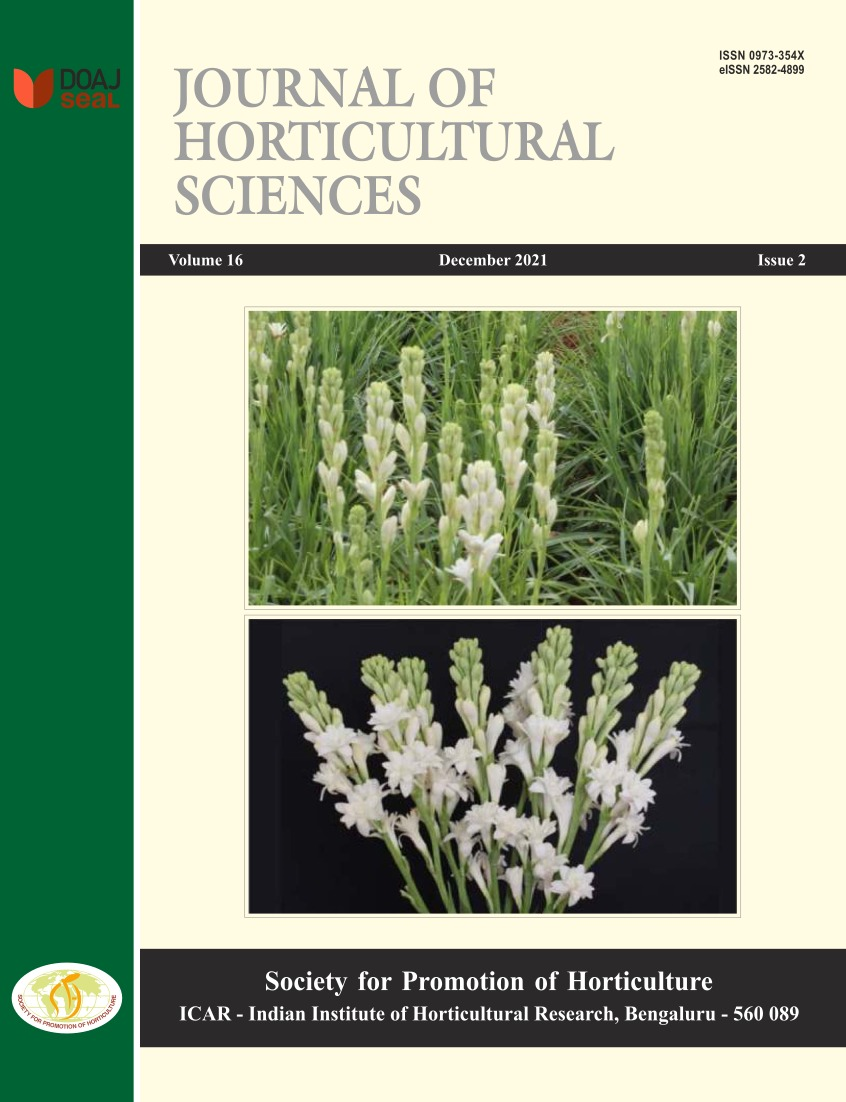Generation mean analysis of important yield traits in Bitter gourd (Momordica charantia)
DOI:
https://doi.org/10.24154/jhs.v16i2.1212Keywords:
Bitter gourd, epistatic interactions, gene action, scaling testAbstract
Generation mean analysis study in bitter gourd was undertaken using six basic generations viz. P1, P2, F1, F2, B1 and B2 population derived from crossing gynoecious line (IIHRBTGy - 491) with two monoecious lines (IIHR Sel -19 -1 and IIHR Sel-78-4). The gynoecious parent was superior for node for first female flowering, number of fruits and yield/plant whereas the monoecious parents were superior for fruit length, fruit diameter and fruit weight. The superior performance of F1 over better parent indicated over-dominance of these traits. F2 plants were significantly diverse. B1 and B2 population exhibited mean value closure to their recurrent parents. Significance of one or more scaling tests, i.e. A, B, C and D in most of the traits revealed the presence of epistasis in both the crosses except for node bearing 1st male flower. Days to 1st female flower opening, node bearing 1st female flower, fruit diameter and yield showed presence of duplicate epistasis whereas days to 1st male flower opening, number of fruits per plant, fruit length and fruit weight showed complimentary epistasis in IIHRBTGy - 491 × IIHR Sel -19 -1 cross. Node bearing 1st female flower, fruit length, fruit diameter and yield showed presence of duplicate epistasis whereas days to 1st female flower opening, days to 1st male flower opening, number of fruits and fruit weight showed complimentary epistasis in IIHRBTGy - 491× IIHR Sel-78-4 cross. Additive gene action may be predominant for inheritance of node bearing 1st male flower.
Downloads
References
Behera, T. K., Behera, S., Bharathi, L. K., John, K. J., Simon, P. W., and Staub, J. E. 2010. Bitter gourd: botany, horticulture, Breeding. Horticultural reviews, 37, 101. DOI: https://doi.org/10.1002/9780470543672.ch2
Deb, A. C. and Khaleque, M. A. 2009. Nature of gene action of some quantitative traits in chickpea (Cicer ar ietinum L.). World Journal of Agricultural Sciences, 5(3), 361-368.
Dey, S. S., Behera, T. K., Munshi, A. D., Rakshit, S. and Bhatia, R. 2012. Utility of gynoecious sex form in heterosis breeding of bitter gourd and genetics of associated vegetative and flowering traits. Indian Journal of Horticulture 69(4): 523–29.
Hayman, B. I. 1960. The separation of epistatic from additive and dominance variation in generation means. Heredity 12: 371–90. DOI: https://doi.org/10.1038/hdy.1958.36
Kumari, M., Behera, T. K., Munshi, A. D., and Talukadar, A. 2015. Inheritance of fruit traits and generation mean analysis for estimation of horticultural traits in bitter gourd. Indian Journal of Horticulture, 72(1), 43-48. DOI: https://doi.org/10.5958/0974-0112.2015.00008.0
Mather, K. and Jinks, J. L. 1982. Introduction to Biometrical Genetics. 3rd edition. Chapman and Hall Ltd., London, 396pp. DOI: https://doi.org/10.1007/978-1-4899-3406-2
Mishra, S., Behera, T. K., Munshi, A. D., Bharadwaj, C., & Rao, A. R. 2015. Inheritance of gynoecism and genetics of yield and yield contributing traits through generation mean analysis in bitter gourd. Indian Journal of Horticulture, 72(2), 218-222. DOI: https://doi.org/10.5958/0974-0112.2015.00042.0
Parihar, A. K., Dixit, G. P. and Singh, D. 2016. Gene interactions and genetics for yield and its attributes in grass pea (Lathyrus sativus L.). Journal of genetics, 95(4), 947-956. DOI: https://doi.org/10.1007/s12041-016-0722-2
Rani, K. R., Reddy, K. R. and Raju, C. S. 2014. Inheritance of yield and its related traits in bitter gourd (Momordica charantia L.). Molecular Plant Breeding, 5. DOI: https://doi.org/10.5376/mpb.2014.05.0001
Rathod, V., Behera, T. K. and Munshi, A. D. 2021. Genetic analysis for yield and its attributes in bitter gourd (Momordica charantia L.). Indian Journal of Agricultural Sciences, 91(1), 68-73. DOI: https://doi.org/10.56093/ijas.v91i1.110928
Shukla, A., Singh, U., Rai, A. K., Bharadwaj, D. R. and Singh, M. 2014. Genetic analysis of yield and yield attributing traits in bitter gourd. Vegetable Science, 41(1), 37-41.
Thangamani, C. 2016. Genetic analysis in bitter gourd (Momordica charantia L.) for yield and component characters. Asian Journal of Horticulture, 11(2), 313-318. DOI: https://doi.org/10.15740/HAS/TAJH/11.2/313-318
Downloads
Published
Issue
Section
License
Copyright (c) 2022 Swamini Bhoi, B Varalakshmi, E Srinivasa Rao, M Pitchaimuthu, K Hima Bindu

This work is licensed under a Creative Commons Attribution-NonCommercial-ShareAlike 4.0 International License.
Authors retain copyright. Articles published are made available as open access articles, distributed under the terms of the Creative Commons Attribution-NonCommercial-ShareAlike 4.0 International License, which permits unrestricted non-commercial use, distribution, and reproduction in any medium, provided the original author and source are credited. 
This journal permits and encourages authors to share their submitted versions (preprints), accepted versions (postprints) and/or published versions (publisher versions) freely under the CC BY-NC-SA 4.0 license while providing bibliographic details that credit, if applicable.





 .
. 











